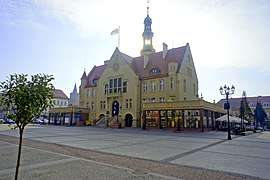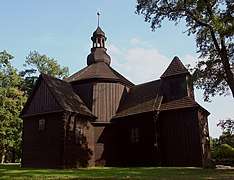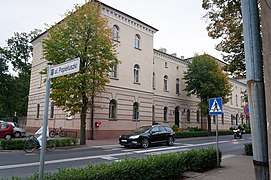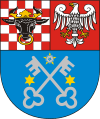Krotoszyn
Krotoszyn [krɔˈtɔʂɨn] (German: Krotoschin, Yiddish: קארטשין Kortshin) is a town in central Poland with 30,010 inhabitants as of 2005. It has been part of the Greater Poland Voivodeship since 1999; it was within Kalisz Voivodeship from 1975 to 1998.
Krotoszyn | |
|---|---|
Market Square | |
 Flag  Coat of arms | |
 Krotoszyn  Krotoszyn | |
| Coordinates: 51°41′N 17°26′E | |
| Country | |
| Voivodeship | |
| County | Krotoszyn County |
| Gmina | Gmina Krotoszyn |
| Established | 15th century |
| Town rights | 1415 |
| Government | |
| • Mayor | Franciszek Marszałek |
| Area | |
| • Total | 22.55 km2 (8.71 sq mi) |
| Highest elevation | 140 m (460 ft) |
| Lowest elevation | 130 m (430 ft) |
| Population (2006) | |
| • Total | 29,421 |
| • Density | 1,300/km2 (3,400/sq mi) |
| Time zone | UTC+1 (CET) |
| • Summer (DST) | UTC+2 (CEST) |
| Postal code | 63–700 to 63–710 |
| Area code(s) | +48 62 |
| Car plates | PKR |
| Climate | Cfb |
| Website | http://www.krotoszyn.pl |
History
Krotoszyn was founded by local nobleman Wierzbięta Krotoski, partipant of the Battle of Grunwald,[1] and was granted town rights in 1415 by King Władysław II Jagiełło.[2] It was a private town owned by the Krotoski, Niewieski, Rozdrażewski and Potocki families, historically located in the Kalisz Voivodeship in the Greater Poland Province of the Polish Crown.[1] After the town suffered a fire in 1453, King Casimir IV of Poland vested it with new privileges, establishing a weekly market and three annual fairs.[1]
It developed as a regional center of trade and crafts, located at the intersection of the Kalisz–Głogów and Toruń–Wrocław trade routes.[2] During the Thirty Years' War, in 1628, Protestant refugees from German states settled in the town.[1] It was plundered by the Swedes, during the Swedish invasion of Poland in 1656, but soon recovered and famous fairs were held there.[2]
It was annexed by Prussia in 1793 during the Second Partition of Poland. In 1807 regained by Poles as part of the short-lived Duchy of Warsaw, in 1815 it was re-annexed by Prussia,[2] and in 1871 it subsequently became part of Germany. During the German rule in the 19th century, the town was located in the Prussian province of Posen.[3] The castle of Krotoszyn was the centre of a mediatized principality formed in 1819 out of the holdings of the Prussian crown and granted to the prince of Thurn und Taxis in compensation for his relinquishing control over the Prussian postal system[3] and it was subjected to Germanisation.[1] During the Polish Greater Poland uprising (1848) Germans and Jews attacked the local Polish committee, and the Poles had to move their activities to Koźmin Wielkopolski.[1] Later on, despite the Germanisation policies, Poles established a number of organizations, including an industrial society, a cooperative bank and a local branch of the "Sokół" Polish Gymnastic Society.[1]
Many inhabitants took part in the Greater Poland uprising (1918–19), during which the town was liberated by the insurgents on 1 January 1919,[2] nearly two months after Poland regained its independence.
The Germans attacked Krotoszyn on 1 September 1939, the first day of the invasion of Poland and World War II.[1] On 2 September they bombed a train with Polish civilians fleeing the Wehrmacht from Krotoszyn, killing 300 people[1][4] and on 4 September they captured the town.[1] The Germans established a transit camp for Polish prisoners of war and over 4,500 Polish soldiers passed through the camp.[1] During the German occupation the Polish population was subject to mass arrests,[5] Germanisation policies, discrimination, expulsions and executions.[1] Nevertheless, local Poles managed to organize the underground resistance movement, which included secret Polish teaching, scout troops and a local branch of the Home Army.[1] The town was liberated by Soviet troops and local Poles in January 1945.[1]
Economy
The dominant trade is in grain and seeds, and the headquarters of the Polish branch of Mahle GmbH is located there.
Notable people
- Katarzyna Grochola (born 1957) – popular Polish writer
- Sir John Monash (1865–1931) – Australian general and civil engineer
- Georg Huth (1867–1906) – German Orientalist
- Isidor Kalisch (1816–1886) – reform rabbi
- Theodor Kullak (1818–1882) – German pianist and composer
- Marian Langiewicz (1827–1887) – Polish military leader of the January Uprising
- Marcin Lijewski (born 1977) – Polish handballer
- Otto Roquette (1824–1896) – German author
- Maria Siemionow (born 1950) – world-renowned Polish scientist and microsurgeon
- Melitta von Stauffenberg (born Schiller) (1903–1945) – famous German test pilot of WWII
- David Zvi Banet (1893–1973) – Orientalist and Professor of Arabic Studies at the Hebrew University in Jerusalem
International relations
Twin towns – Sister cities
Krotoszyn is twinned with:






Gallery
- Historic townhouses at the Market Square
.jpg) Gothic Saint John the Baptist church
Gothic Saint John the Baptist church Krotoszyn Town Hall
Krotoszyn Town Hall Preserved old wooden church of Saints Fabian, Roch and Sebastian
Preserved old wooden church of Saints Fabian, Roch and Sebastian District court
District court- Katyn massacre memorial at the local cemetery
References
- "Kalendarium do roku 1994 - Paweł Anders". Portal - Krotoszyn - oficjalna strona miasta (in Polish). Retrieved 8 March 2020.
- "Krotoszyn - Dzieje Miast". Region Wielkopolska (in Polish). Retrieved 8 March 2020.
- Chisholm, Hugh, ed. (1911). . Encyclopædia Britannica. 15 (11th ed.). Cambridge University Press. pp. 928–929.
- Maria Wardzyńska, Był rok 1939. Operacja niemieckiej policji bezpieczeństwa w Polsce. Intelligenzaktion, IPN, Warszawa, 2009, p. 89 (in Polish)
- Wardzyńska, Op. cit., p. 116
| Wikimedia Commons has media related to Krotoszyn. |
